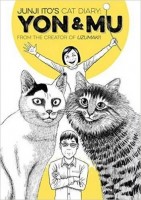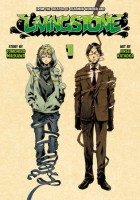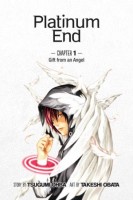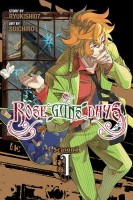Do you own a cat tea cosy? Is there an enormous feline jungle gym in your living room? Have you lost entire afternoons to watching YouTube videos of cats opening doors, playing pianos, and riding Roombas? If you answered “yes” to at least one of the following questions, this week’s column is for you, as I’ll be reviewing two cat-centric comics: Osamu Tezuka’s Brave Dan–a boy-and-his-tiger story–and Kanata Konami’s FukuFuku: Kitten Tales–a manga about cats doing normal cat things.
 Brave Dan
Brave Dan
By Osamu Tezuka
Rated Teen, for readers 13 and up
Digital Manga Publishers, Inc., $15.95
Brave Dan begins as a rollicking adventure: Kotan, an orphaned Ainu boy, befriends Dan, a “man-eating” tiger, and embarks on a quest with him to find a valuable treasure. The pair dodges bullets, escapes from a helicopter, and tangles with guardian spirits in their search for the tomb of an ancient Ainu warrior. As the story enters its final act, however, a darker subplot emerges, one in which Dan is forced to confront the wisdom of associating with humans.
Though Tezuka makes frequent reference to Kotan’s Ainu heritage, this plot strand is more window dressing than serious thematic element; Kamuiroji’s tomb looks more like a set from a Flash Gordon or Tarzan serial than an authentic expression of Ainu culture. (Granted, it’s a pretty nifty tomb; Indiana Jones would have had a field day exploring it.) Tezuka is on firmer ground when staging a chase or a fight. In one memorable scene, for example, Dan plunges into a lake to save Kotan from an enormous spider-demon. Tezuka captures the fluidity and speed of Dan’s attacks with a few carefully chosen “snapshots” of him tumbling and twisting in the water, struggling to crush the monster with his paws. Small details–such as the trail of bubbles from each of Dan’s legs–remind us that in this underwater setting, Dan has a fleeting window of opportunity to save his friend. By the time that he and Kotan burst to the lake’s surface, we’re gasping for air, too–a testament to Tezuka’s ability to transport the reader to the scene of the action.
Tezuka’s artwork also plays an important role in garnering sympathy for Dan, establishing the tiger’s bravery, intelligence, and unwavering loyalty to Kotan. Though Tezuka can’t resist some ham-fisted touches–Dan actually shakes his paw at the sky in one scene–Dan’s essential tigerness is never compromised. The emphasis on Dan’s animal nature reminds us that his friendship with Kotan can only exist apart from human society; kind and smart as Dan may be, adults perceive him as a threat, to be killed or contained in a zoo.
The bottom line: If you still bear scars from reading The Yearling and Old Yeller, be warned: Dan is as doomed as those other noble animal protagonists. Less sensitive souls, however, can enjoy Brave Dan as both a gonzo adventure story and a meditation on the perils of interspecies friendships. Recommended for readers ten and up.
 FukuFuku: Kitten Tales, Vol. 1
FukuFuku: Kitten Tales, Vol. 1
By Kanata Konami
All Ages
Vertical Comics, $10.95
FukuFuku: Kitten Tales is perfectly calibrated to elicit an “awwww” and a chuckle on every page. The title character–a spunky calico–does predictably cute things: she falls asleep in odd places, escapes from a sudsy bath, plays with her food, and snatches a fish from the table. Unlike Chi, star of Konami’s other hit manga, FukuFuku doesn’t voice her thoughts about her new owner, or the strangeness of her new surroundings; she simply does what she pleases. Konami’s minimalist artwork captures the nuances of FukuFuku’s moods surprisingly well, however, as Konami bends and stretches the kitten’s moon-shaped face into an astonishing range of smiles, scowls, and grimaces. Absent a plot or a deeper sense of how FukuFuku sees her world, the story hits fewer emotional notes than Chi’s Sweet Home, focusing almost exclusively on the kind of ordinary cat behavior that’s been documented copiously on YouTube. You may find that the vignettes–charming as they are–have a sameness about them that prevents them from being genuinely funny or surprising.
The bottom line: As with Chi’s Sweet Home, Konami demonstrates a talent for drawing winsome kitties doing winsome things. She’s also cornered the market on disdainful feline reaction shots.
Reviews: ANN columnist Rebecca Silverman posts an early review of Inio Asano’s critically lauded drama Goodnight Pun-Pun, while Seth Hahne, host of Good OK Bad, tackles another Asano work: A Girl on the Shore.
Mark Pelligrini on vol. 3 of AKIRA (AiPT!)
Sean Gaffney on vol. 7 of Blood Lad (A Case Suitable for Treatment)
Adrienne on vol. 1 of Bloody Mary (Heart of Manga)
Sean Gaffney on The Boy and the Beast (A Case Suitable for Treatment)
Julie on The Cinderella Solution (Manga Maniac Cafe)
Julie on Crowns and a Cradle (Manga Maniac Cafe)
ebooksgirl on vol. 1 of FukuFuku: Kitten Tales (Geek Lit Etc.)
Karen Maeda on vol. 1 of JoJo’s Bizarre Adventure, Part 2: Battle Tendency (Sequential Tart)
Wolfen Moondaughter on vol. 23 of Kimi ni Todoke: From Me to You (Sequential Tart)
Nick Creamer on vol. 3 of My Hero Academia (Anime News Network)
David Brooke on vol. 5 of One-Punch Man (AiPT!)
Ash Brown on vol. 1 of Persona 4 (Experiments in Manga)
Jordan Richards on vol. 1 of Pokemon Adventures (AiPT!)
Sheena McNeil on vol. 2 of QQ Sweeper (Sequential Tart)
Wolfen Moondaughter on vol. 1 of Gakyuu Hotei: School Judgment (Sequential Tart)
Rebecca Silverman on vol. 3 of Umineko When They Cry Episode 5: End of the Golden Witch (Anime News Network)
Austin Lanari on issue no. 13 of Weekly Shonen Jump (Comic Bastards)

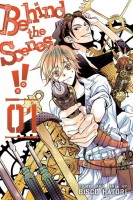 Behind the Scenes!!, Vol. 1
Behind the Scenes!!, Vol. 1
 Idol Dreams, Vol. 1
Idol Dreams, Vol. 1 Monthly Girls’ Nozaki-Kun, Vol. 1
Monthly Girls’ Nozaki-Kun, Vol. 1